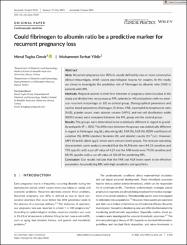Could fibrinogen to albumin ratio be a predictive marker for recurrent pregnancy loss
Özet
Aims Recurrent pregnancy loss (RPL) is usually defined by two or more consecutive clinical miscarriages, which causes psychological trauma for couples. In this study, we aimed to investigate the predictive role of fibrinogen to albumin ratio (FAR) in patients with RPL. Methods Pregnant women in their first trimester of pregnancy were included in the study and divided into two groups as RPL patients (n: 44) and patients with no previous recurrent miscarriage (n: 60) as control group. Demographical parameters and routine blood parameters (fibrinogen, D-dimer, FAR, neutrophil to lymphocyte ratio [NLR], platelet count, main platelet volume [MPV], and red cell distribution width [RDW] values) were compared between the RPL group and the control group. Results The groups were determined to be statistically different in regard to gravidity and parity (P < .001). The difference between the groups was statistically different in regard to fibrinogen (mg/dL), albumin (g/dL), FAR (%), NLR (%), RDW-coefficient of variation (%), RDW-standard deviation (fl), and platelet counts (10(-3)/mu L). However, MPV (fl) and D-dimer (mu g/L) levels were similar in both groups. The receiver operating characteristic curve analysis revealed that the NLR levels were 84.1% sensitive and 75% specific with a cut-off value of 4.27 and the FAR levels were 79.5% sensitive and 88.3% specific with a cut-off value of 105.69 for predicting RPL. Conclusion Our results indicate that the FAR and NLR levels seem to be effective parameters for predicting RPL with high sensitivity and specificity.
Kaynak
International Journal of Clinical PracticeBağlantı
https://hdl.handle.net/20.500.12868/1621https://onlinelibrary.wiley.com/doi/10.1111/ijcp.14520


















